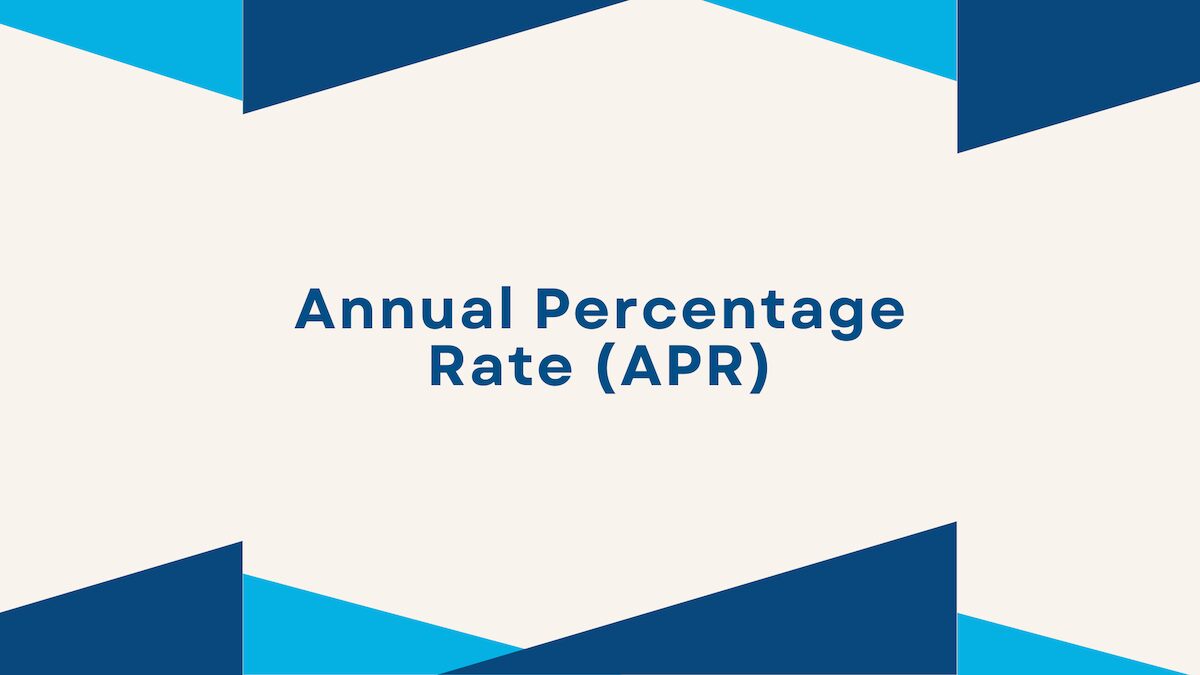[vc_row][vc_column][vc_column_text]
The Annual Percentage Rate, or APR, is a term many encounter when dealing with loans, credit cards, and other financial products. For nonprofits managing credit wisely, understanding APR can be instrumental in reducing borrowing costs and making informed financial decisions.
This guide will break down what APR means, how it’s calculated, and why it’s essential for your nonprofit organization’s financial health.
Quick note – at the bottom of this guide is a free Annual Percentage Rate (APR) calculator.
Feel free to use it and get a better idea what your monthly payments could be.
What Is Annual Percentage Rate (APR)?
APR represents the annual cost of borrowing money, expressed as a percentage. Unlike the interest rate, which only considers the percentage cost of borrowing, APR includes additional fees or costs, such as origination fees or monthly maintenance fees.
For nonprofits, understanding APR can provide a clearer picture of the actual cost associated with using credit products.
For example, if your nonprofit uses a credit card with a 15% APR, it would mean that if the balance is carried from month to month, the annual cost of borrowing is approximately 15% of the amount borrowed.
Why APR Matters for Nonprofits
Nonprofits often have limited budgets, and managing resources effectively is critical to fulfilling their missions. Here’s why understanding APR is essential:
- Transparency in Costs: APR helps nonprofits understand the full cost of borrowing or carrying a credit balance.
- Budget Planning: By knowing the APR, nonprofits can more accurately plan for monthly and annual expenses associated with credit card debt.
- Financial Decision-Making: When comparing financial products, nonprofits can use APR to identify the most cost-effective options, saving on interest and fees.
By being aware of APR and its implications, nonprofits can make more strategic financial decisions.
Types of APR in Credit Cards
Credit cards often have multiple APRs depending on the type of transaction. Here are the most common types:
- Purchase APR: The interest rate applied to purchases made with the card. This is the APR most people think of when they consider credit card rates.
- Cash Advance APR: A typically higher rate charged for withdrawing cash using the credit card.
- Balance Transfer APR: The interest rate applied to any balance transferred from another credit card.
- Introductory or Promotional APR: A lower rate offered temporarily as an incentive. After the promotional period ends, the APR reverts to the regular rate.
- Penalty APR: A higher interest rate triggered by missed payments or default on the card agreement.
For nonprofits, understanding these APR types can help decide how best to use the credit card and avoid unnecessary costs.
How APR is Calculated on a Credit Card Balance
APR isn’t applied to your balance all at once; instead, it’s calculated periodically, typically daily, based on the daily periodic rate (DPR). Here’s how it works:
- Determine the Daily Periodic Rate (DPR): This is your APR divided by the number of days in a year (365). For example, if your APR is 15%, the DPR is 0.04109% (15% / 365).
- Multiply DPR by Your Balance: At the end of each day, the credit card issuer multiplies the DPR by your current balance to determine the interest for that day.
- Add Daily Interest Charges: The daily interest charges are added to your balance, compounding over time if you don’t pay off the balance each month.
Understanding this compounding effect is important for nonprofits as it emphasizes why carrying a balance can quickly increase debt.
Nonprofit Resources
The Charity Charge resource hub is dedicated to providing tips, tools, and information to help your nonprofit create and grow a modern organization. Learn more
Fixed APR vs. Variable APR
Another factor nonprofits should be aware of is the distinction between fixed and variable APRs:
- Fixed APR: A fixed APR does not change over time, providing stability in interest rates. However, changes in market conditions or issuer policy can still lead to adjustments, usually with advance notice.
- Variable APR: Variable APRs fluctuate with changes in an underlying index, such as the prime rate. For nonprofits, variable APRs can mean unpredictable expenses, as the interest rate may rise or fall without notice.
How APR Differs from Interest Rate
APR and interest rates are often confused but serve different purposes. The interest rate is the basic cost of borrowing without any additional fees. APR, on the other hand, incorporates interest along with fees or costs associated with the card, offering a more comprehensive picture of the borrowing cost.
For nonprofits, focusing on APR rather than just the interest rate gives a clearer view of overall expenses, particularly when evaluating or comparing credit cards.
Key Factors That Influence APR
APR isn’t a fixed value for everyone; it varies based on several factors. Understanding these factors can help nonprofits anticipate the kind of APR they may encounter.
- Credit Score: Nonprofits with a strong credit history may qualify for lower APRs, as a higher credit score generally indicates lower risk for lenders.
- Market Conditions: Economic factors, such as inflation or changes in the prime rate, affect variable APRs.
- Card Type and Terms: Premium cards or cards with rewards may have higher APRs, whereas basic or secured credit cards often offer lower APRs.
- Promotions: Many credit cards offer promotional or introductory APRs to attract new cardholders.
By understanding these elements, nonprofits can better prepare and potentially negotiate for more favorable APR terms.
Strategies for Managing APR and Minimizing Costs
Managing APR effectively is crucial for nonprofits to avoid unnecessary costs. Here are a few strategies to consider:
- Pay Off Balances Monthly: Avoiding a balance at the end of the month can help your organization avoid interest charges altogether.
- Leverage Introductory APRs Wisely: If a credit card offers an introductory 0% APR, use it strategically, such as for planned expenses that you’re confident can be repaid before the promotional period ends.
- Consolidate Debt Carefully: Transferring high-interest balances to a lower-APR credit card can save on interest, but be mindful of transfer fees.
- Negotiate Lower APRs: Some issuers are open to negotiating lower APRs, particularly for nonprofits with strong credit histories and on-time payment records.
- Monitor APR Changes: Keep an eye on any changes in variable APRs, especially if linked to external benchmarks, so you can anticipate potential cost increases.
With these practices, nonprofits can minimize the financial impact of APR and allocate more funds towards their mission-driven activities.
How to Find and Compare APRs for Nonprofit Credit Cards
Comparing credit card APRs is an essential step for nonprofits in selecting the right card. Here’s what to look for:
- Review APR Terms: Always review the terms for purchase, cash advance, and penalty APRs.
- Check for Promotional Offers: Some nonprofit-focused credit cards offer lower APRs or introductory rates.
- Evaluate Fees: Look beyond APR and consider additional fees, such as annual or transfer fees, as these contribute to the overall cost.
For nonprofits, seeking a card with low APRs, minimal fees, and nonprofit-oriented perks can make a significant difference in managing credit efficiently.
Frequently Asked Questions
What is a Good APR for Nonprofit Credit Cards? A good APR for nonprofits depends on creditworthiness and market conditions but generally falls between 12%–18%. However, always compare offers to find the most favorable terms.
How Can Nonprofits Avoid High APR Charges? Nonprofits can avoid high APR charges by paying off balances monthly, using introductory APRs strategically, and negotiating lower rates.
Are There Credit Cards with Special APRs for Nonprofits? Yes, some financial institutions offer credit cards designed for nonprofits that may include lower APRs, waived fees, or other special terms to support their mission.
Can Nonprofits Negotiate APR on Credit Cards? In some cases, yes. If your nonprofit has a strong credit history, reach out to your issuer to request a lower APR.
How Often Does APR Change on a Variable Rate Card? Variable APRs change according to market conditions, often tied to the prime rate, and may adjust monthly or quarterly.
What Happens to APR if Payments Are Late? Late payments can trigger a penalty APR, which is higher than the regular APR and can increase borrowing costs significantly.
[/vc_column_text][us_html css=”%7B%22default%22%3A%7B%22color%22%3A%22_content_overlay%22%2C%22font-family%22%3A%22body%22%2C%22font-weight%22%3A%22500%22%7D%7D”]JTNDZGl2JTNFJTBBJTIwJTIwJTIwJTIwJTNDaDIlM0UlM0NiJTNFQ3JlZGl0JTIwQ2FyZCUyMEFQUiUyMENhbGN1bGF0b3IlM0MlMkZiJTNFJTNDJTJGaDIlM0UlMEElMjAlMjAlMjAlMjAlM0NsYWJlbCUyMGZvciUzRCUyMmJhbGFuY2UlMjIlM0VDcmVkaXQlMjBDYXJkJTIwQmFsYW5jZSUyMCUyOCUyNCUyOSUzQSUzQyUyRmxhYmVsJTNFJTBBJTIwJTIwJTIwJTIwJTNDaW5wdXQlMjB0eXBlJTNEJTIybnVtYmVyJTIyJTIwaWQlM0QlMjJiYWxhbmNlJTIyJTIwcGxhY2Vob2xkZXIlM0QlMjJFbnRlciUyMGN1cnJlbnQlMjBiYWxhbmNlJTIyJTIwJTJGJTNFJTBBJTBBJTIwJTIwJTIwJTIwJTNDbGFiZWwlMjBmb3IlM0QlMjJhcHIlMjIlM0VBbm51YWwlMjBQZXJjZW50YWdlJTIwUmF0ZSUyMCUyOEFQUiUyOSUyMCUyOCUyNSUyOSUzQSUzQyUyRmxhYmVsJTNFJTBBJTIwJTIwJTIwJTIwJTNDaW5wdXQlMjB0eXBlJTNEJTIybnVtYmVyJTIyJTIwaWQlM0QlMjJhcHIlMjIlMjBzdGVwJTNEJTIyMC4wMSUyMiUyMHBsYWNlaG9sZGVyJTNEJTIyRW50ZXIlMjBBUFIlMjIlMjAlMkYlM0UlMEElMEElMjAlMjAlMjAlMjAlM0NsYWJlbCUyMGZvciUzRCUyMm1vbnRobHlQYXltZW50JTIyJTNFTW9udGhseSUyMFBheW1lbnQlMjAlMjglMjQlMjklM0ElM0MlMkZsYWJlbCUzRSUwQSUyMCUyMCUyMCUyMCUzQ2lucHV0JTIwdHlwZSUzRCUyMm51bWJlciUyMiUyMGlkJTNEJTIybW9udGhseVBheW1lbnQlMjIlMjBwbGFjZWhvbGRlciUzRCUyMkVudGVyJTIwbW9udGhseSUyMHBheW1lbnQlMjBhbW91bnQlMjIlMjAlMkYlM0UlMEElMEElMjAlMjAlMjAlMjAlM0NidXR0b24lMjBvbmNsaWNrJTNEJTIyY2FsY3VsYXRlQ3JlZGl0Q2FyZEFQUiUyOCUyOSUyMiUzRUNhbGN1bGF0ZSUzQyUyRmJ1dHRvbiUzRSUwQSUwQSUyMCUyMCUyMCUyMCUzQ2RpdiUyMGlkJTNEJTIycmVzdWx0JTIyJTNFJTNDJTJGZGl2JTNFJTBBJTNDJTJGZGl2JTNFJTBBJTBBJTNDc2NyaXB0JTNFJTBBZnVuY3Rpb24lMjBjYWxjdWxhdGVDcmVkaXRDYXJkQVBSJTI4JTI5JTIwJTdCJTBBJTIwJTIwJTIwJTIwY29uc3QlMjBiYWxhbmNlJTIwJTNEJTIwcGFyc2VGbG9hdCUyOGRvY3VtZW50LmdldEVsZW1lbnRCeUlkJTI4JTIyYmFsYW5jZSUyMiUyOS52YWx1ZSUyOSUzQiUwQSUyMCUyMCUyMCUyMGNvbnN0JTIwYXByJTIwJTNEJTIwcGFyc2VGbG9hdCUyOGRvY3VtZW50LmdldEVsZW1lbnRCeUlkJTI4JTIyYXByJTIyJTI5LnZhbHVlJTI5JTNCJTBBJTIwJTIwJTIwJTIwY29uc3QlMjBtb250aGx5UGF5bWVudCUyMCUzRCUyMHBhcnNlRmxvYXQlMjhkb2N1bWVudC5nZXRFbGVtZW50QnlJZCUyOCUyMm1vbnRobHlQYXltZW50JTIyJTI5LnZhbHVlJTI5JTNCJTBBJTBBJTIwJTIwJTIwJTIwaWYlMjAlMjhpc05hTiUyOGJhbGFuY2UlMjklMjAlN0MlN0MlMjBpc05hTiUyOGFwciUyOSUyMCU3QyU3QyUyMGlzTmFOJTI4bW9udGhseVBheW1lbnQlMjklMjAlN0MlN0MlMjBtb250aGx5UGF5bWVudCUyMCUzQyUzRCUyMDAlMjklMjAlN0IlMEElMjAlMjAlMjAlMjAlMjAlMjAlMjAlMjBkb2N1bWVudC5nZXRFbGVtZW50QnlJZCUyOCUyMnJlc3VsdCUyMiUyOS5pbm5lckhUTUwlMjAlM0QlMjAlMjJQbGVhc2UlMjBlbnRlciUyMHZhbGlkJTIwaW5wdXRzLiUyMiUzQiUwQSUyMCUyMCUyMCUyMCUyMCUyMCUyMCUyMHJldHVybiUzQiUwQSUyMCUyMCUyMCUyMCU3RCUwQSUwQSUyMCUyMCUyMCUyMGNvbnN0JTIwbW9udGhseUludGVyZXN0UmF0ZSUyMCUzRCUyMGFwciUyMCUyRiUyMDEwMCUyMCUyRiUyMDEyJTNCJTBBJTIwJTIwJTIwJTIwbGV0JTIwcmVtYWluaW5nQmFsYW5jZSUyMCUzRCUyMGJhbGFuY2UlM0IlMEElMjAlMjAlMjAlMjBsZXQlMjB0b3RhbEludGVyZXN0JTIwJTNEJTIwMCUzQiUwQSUyMCUyMCUyMCUyMGxldCUyMG1vbnRocyUyMCUzRCUyMDAlM0IlMEElMEElMjAlMjAlMjAlMjB3aGlsZSUyMCUyOHJlbWFpbmluZ0JhbGFuY2UlMjAlM0UlMjAwJTI5JTIwJTdCJTBBJTIwJTIwJTIwJTIwJTIwJTIwJTIwJTIwY29uc3QlMjBpbnRlcmVzdCUyMCUzRCUyMHJlbWFpbmluZ0JhbGFuY2UlMjAlMkElMjBtb250aGx5SW50ZXJlc3RSYXRlJTNCJTBBJTIwJTIwJTIwJTIwJTIwJTIwJTIwJTIwdG90YWxJbnRlcmVzdCUyMCUyQiUzRCUyMGludGVyZXN0JTNCJTBBJTIwJTIwJTIwJTIwJTIwJTIwJTIwJTIwcmVtYWluaW5nQmFsYW5jZSUyMCUzRCUyMHJlbWFpbmluZ0JhbGFuY2UlMjAlMkIlMjBpbnRlcmVzdCUyMC0lMjBtb250aGx5UGF5bWVudCUzQiUwQSUwQSUyMCUyMCUyMCUyMCUyMCUyMCUyMCUyMGlmJTIwJTI4cmVtYWluaW5nQmFsYW5jZSUyMCUzRSUyMGJhbGFuY2UlMjklMjAlN0IlMjAlMjAlMkYlMkYlMjBQcmV2ZW50cyUyMGluZmluaXRlJTIwbG9vcCUyMGlmJTIwcGF5bWVudCUyMGlzJTIwdG9vJTIwbG93JTBBJTIwJTIwJTIwJTIwJTIwJTIwJTIwJTIwJTIwJTIwJTIwJTIwZG9jdW1lbnQuZ2V0RWxlbWVudEJ5SWQlMjglMjJyZXN1bHQlMjIlMjkuaW5uZXJIVE1MJTIwJTNEJTIwJTIyTW9udGhseSUyMHBheW1lbnQlMjBpcyUyMHRvbyUyMGxvdyUyMHRvJTIwY292ZXIlMjB0aGUlMjBpbnRlcmVzdC4lMjIlM0IlMEElMjAlMjAlMjAlMjAlMjAlMjAlMjAlMjAlMjAlMjAlMjAlMjByZXR1cm4lM0IlMEElMjAlMjAlMjAlMjAlMjAlMjAlMjAlMjAlN0QlMEElMjAlMjAlMjAlMjAlMjAlMjAlMjAlMjBtb250aHMlMkIlMkIlM0IlMEElMjAlMjAlMjAlMjAlN0QlMEElMEElMjAlMjAlMjAlMjBjb25zdCUyMHllYXJzJTIwJTNEJTIwTWF0aC5mbG9vciUyOG1vbnRocyUyMCUyRiUyMDEyJTI5JTNCJTBBJTIwJTIwJTIwJTIwY29uc3QlMjByZW1haW5pbmdNb250aHMlMjAlM0QlMjBtb250aHMlMjAlMjUlMjAxMiUzQiUwQSUwQSUyMCUyMCUyMCUyMGRvY3VtZW50LmdldEVsZW1lbnRCeUlkJTI4JTIycmVzdWx0JTIyJTI5LmlubmVySFRNTCUyMCUzRCUyMCU2MCUwQSUyMCUyMCUyMCUyMCUyMCUyMCUyMCUyMCUzQ3AlM0VUaW1lJTIwdG8lMjBQYXklMjBPZmYlMjBCYWxhbmNlJTNBJTIwJTI0JTdCeWVhcnMlN0QlMjB5ZWFycyUyMGFuZCUyMCUyNCU3QnJlbWFpbmluZ01vbnRocyU3RCUyMG1vbnRocyUzQyUyRnAlM0UlMEElMjAlMjAlMjAlMjAlMjAlMjAlMjAlMjAlM0NwJTNFVG90YWwlMjBJbnRlcmVzdCUyMFBhaWQlM0ElMjAlMjQlMjQlN0J0b3RhbEludGVyZXN0LnRvRml4ZWQlMjgyJTI5JTdEJTNDJTJGcCUzRSUwQSUyMCUyMCUyMCUyMCU2MCUzQiUwQSU3RCUwQSUzQyUyRnNjcmlwdCUzRSUwQQ==[/us_html][/vc_column][/vc_row]

















